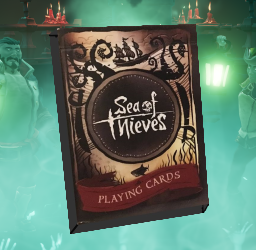
Sea of Thieves Inspired Card Games
Whether you’re on deck hoisting your sails, or you’re hoisting a card from the deck, pirates and playing cards seem to go together fairly well. Spoiling us with a bit of parlor parlay, Rare provided a deck of Sea of Thieves themed cards during the lead-up to the release of the game. You’re free to use the cards to play a quick game of Euchre or Rummy, and there’s even a game called Karnath Kards included within – but if you’ve ever wanted to play a competitively cunning game of chance themed after the three original Trading Companies, you’ve come to the right place. We’ve come up with our own Sea of Thieves card games with their own unique rules and strategies that you can play on any deck of cards for hours of fun with one other friendly pirate or adversarial swashbuckler! Blow the man down!



After years of searching for the Gold Hoarders Fortune, two rival crews have discovered its location, arriving at the exact spot on the isle at the same time. Somewhere underneath their feet lie the riches of three kingdoms, but in their greed they have decided against an alliance, choosing instead to allow the riches to be collected by the first crew to unearth the treasure of the three Kings. In this game, spades are valued over hearts…

- Begin by removing all Kings, Queens, Jacks, Aces and Jokers from the deck. They will all be shuffled and placed face down together – this pile is known as the ‘Gold Hoarders Treasure’
- The remaining number cards will be shuffled and each player will be dealt 5 cards face down – the remaining deck will be placed away from the ‘Gold Hoarders Treasure’ and will serve as the deck players will draw from.
- Cards which have been previously played are to be collected in a separate pile – in an instance where the deck is depleted, this pile will be reshuffled to serve as the new deck to draw from.

- When ready, both players will select their highest card and place it face down in front of them, and will reveal their cards at the same time to each other.
- Whoever has the higher number card of that turn will get to ‘dig’, drawing a card from the ‘Gold Hoarders Treasure’ which they will keep to themselves and return to their hand.
- Whoever has the lower number card of that turn must draw one card from the remaining deck of number cards, keeping it to themselves and returning it to their hand.
- The following turn, players will instead select their lowest card and place it face down in front of them. After revealing, it will be the player with the lowest card who may dig in the ‘Gold Hoarders Treasure’, and the player with the higher card who will have to draw from the remaining deck. This will continue every other turn, alternating between highest and lowest victories.
- If both players reveal the same number card, the winner is determined by the suit value with Spades being judged highest, followed by Diamonds, Clubs and lastly, Hearts.
- When a King is drawn by either player from the Gold Hoarders Treasure, they must place the card face up on their side of the field and draw one card from the Gold Hoarders Treasure.
- If at any point, a player has three-of-a-kind in any suit (Three Aces, Three Jacks, Three Queens) They will reveal the three cards, return them to the bottom of the ‘Gold Hoarders Treasure’ and draw three cards from the ‘Gold Hoarders Treasure.
- If a player finds that their hand is filled with suit cards and therefore are unable to play a number card for the option to dig, they must reveal their hand, selecting three suit cards of their choosing to be returned to the bottom of the ‘Gold Hoarders Treasure’. They will then draw three number cards from the deck in order to replenish their hand.

- The winner is the first player to possess any three Kings on their side of the field at one time, which they will then reveal to their opponent to end the game.
- If both players possess two Kings on the field each rendering the game unwinnable, they must draw one card from the number deck each and reveal it – the highest card will be declared the winner.



Long ago, three Queens would harness the same ethereal and arcane abilities as practiced by the Oracles within the Order of Souls, but in death they would discover that the passage beyond was impassable for their meddling. In order to free the souls of the three Queens, two players will need to use their own mystic influence and otherworldly abilities to find them amongst the other wayward specters in the Divination of Souls. Cunning and Strategy are rewarded here; players finding themselves betrayed by their emotions during the search will only serve to help their opponents find the Queens first…

- Begin by removing all Kings, Queens, Jacks and Aces from the deck. They will all be shuffled together and arranged face down in two rows of eight cards in the middle of the playing field – this arrangement is known as the ‘The Divination of Souls’
- The remaining number cards along with both of the Joker cards will then be shuffled together and both players will be dealt 5 cards face down – The remaining deck will be placed away from the Divination of Souls so it may not disrupt the reading, and this will serve as the deck players will draw from.
- Cards which have been previously played are to be collected in a separate pile – in an instance where the deck is depleted or a Joker is played, this pile will be reshuffled to serve as the renewed deck to draw from.

- In order to determine which player will start the game, both players will declare a suit of their choosing (Diamonds, Hearts, Spades or Clubs) out loud. When this has been decided, one player will turn over the first card of the deck to reveal its suit. If the suit has not been claimed by either player, or if the Joker is revealed, further cards will be revealed until it matches either players declared suit. When this is done, shuffle the deck.
- The player who managed to scry the correct suit will prepare to play his or her first hand by choosing one of the cards in their hand and revealing it to the other player, challenging them to play a higher card of the same suit.
- If the opponent has a higher suit in response, they will be declared the winner of that hand, and will select one card from the Divination of Souls and return it to their hand without revealing it to the other player. The other player will sacrifice one card from their hand (typically the lowest) and then draw a card from the deck.
- If the opponent does not have a higher suit in response, the unchallenged player will select one card from the Divination of Souls to be added to their hand discretely while the other player must sacrifice a card from their hand and then draw a new card from the deck.
- The turns will alternate between players who will challenge each other to play a higher suit of their choosing.
- If a player has a card from the Divination of Souls in their hand, and the suit from that card is challenged by an opponent (for instance, if a player has a Jack of Hearts, and the Hearts suit has been called), they must return it to the Divination of Souls face down in addition to playing or sacrificing a card in response.
- When each turn ends, the players must make sure they draw enough cards to bring their total back to five in response to whatever cards may have been returned to the Divination of Souls in addition to their sacrifices.
- The Joker card serves a very specific function if it is drawn from the deck. At any time of a players choosing during their turn, they may show the Joker card to their opponent. When this is done, the opponent must show the player their hand, and they must follow one of three instructions upon reveal;
a.) If the hand-showing player has any number of Queen Suit cards in their hand, one must be returned to the Divination of Souls once both players have seen it. The Joker is then combined with the previously played cards to be reshuffled into the deck and the hand-showing player starts their turn.
b.) If the hand-showing player also has a Joker of their own in their hand, the challenging player whom first played the Joker must show their hand as well. In addition, the defending player who holds the second Joker may point to any two cards in the Divination of Souls and have it revealed to both players. If any of the cards are Queens, they are given to the defending player with the second Joker. Both Joker cards are then returned to the deck and combined with the previously played cards to be reshuffled into the deck and the hand-showing player starts their turn.
c.) If the hand-showing player has neither Queens nor Jokers, the Joker card is combined with the previously played cards to be reshuffled into the deck and the hand-showing player starts their turn.

- The winner is the first player to possess any of the three Queens from the Divination of Souls in their hand at one time, which they will then reveal to their opponent to end the game.


Those who favor the Merchant’s Alliance know the importance of heeding a pocket watch and delivering proven results. The Merchant’s Contract will test both of these attributes in a fast-paced game of chance for two pirates looking to rid their ship of cargo first. It’s not all above board though; there’s still plenty of unsavory tactics you can utilize with your face cards to set contract expiration sooner than intended, much to the chagrin of your outpaced rival with too many cards in their hands, and cargo in the hull…


- Begin by removing the Jokers from the deck. All remaining cards will be shuffled together and placed in a single deck in the middle of the playing field. When this is done, each player will be dealt five cards face down.
- Draw two further cards and reveal them, placing each on either side of the deck facing upwards – this will be referred to as the ‘Merchant’s Contract’.
- Only number cards can be left open in the Merchants Contracts; if one or both of the cards revealed during set-up is a face card, draw another card from the deck and place it over top, and continue this process until you’ve reached a number card rather than a face card.

- In a game of Merchant’s Contract, the Captain with the most sailing experience (eldest age) will start.
If the game is played consecutively, the eldest Captain must allow the younger Captain to go first, and each will get a chance to lead every other turn. - During each turn, players will attempt to match the current suits shown in the Merchant’s Contract with at least one card they have in their current hand.
- If the player possesses a number card that matches the suit of the Merchant’s Contract they can place the card on top of the Merchants Contract of that suit and end their turn.
- Conversely, if the player possesses a face card of any suit, they may choose to place that card on either of the Merchant’s Contracts; this will signify that the Contract for that particular suit has expired and will end their turn.
- The instant that a suit has expired in the Merchant’s Contract, a number card from the deck must be drawn to cover it. If another face card is drawn instead, the process will continue until a number card is drawn.
- If a player has neither a relevant suit or a face card in their hand, they must end their turn by drawing from the deck – even if they draw a face card, or a number card that matches the suit in the Merchant’s Contract, they must wait until the next turn to use it.
- Only one card can be placed on a Merchant’s Contract per turn.

- The winner is the first player to successfully deliver all of their cards to the Merchants Contract before the other player has done so.
- If the end of the deck is reached while either player still has a hand remaining, the player holding the least amount of cards will be declared the winner.
Categories: News, Special Features
0 Comments
This post has been left all alone with no comments. Don't leave it lonesome - give it some company with a comment.